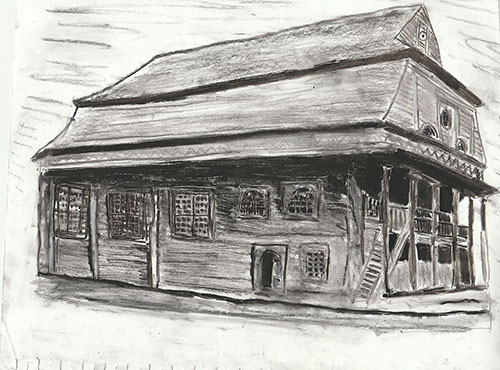Lost Treasures: The Wooden Synagogues of Eastern Europe The Artwork of Bill Farran
Lutomiersk, Poland - Sumi-e Style Brush Painting
Lutomiersk, Poland - Sumi-e Style Brush Painting
Yiddish: Lutomiersk
The noble family who owned Lutomiersk invited Jews to settle in the town in the 1600’s. Sometime during the 1700’s the town owners further encouraged Jewish enterprise by providing loans. By the middle of the 18th Century most of the town’s population was Jewish. In addition to commercial trading, Jews were employed as shopkeepers, weavers, tanners, tailors, and carpenters. The Wooden Synagogue was built between 1763 and 1765 by Hillel Benjamin of Lasko* and destroyed during World War I.
In 1815 the Polish owners of Lutomiersk organized a home-based weaving industry. Jewish merchants supplied the weavers with raw materials and marketed their finish products, When Lodz became a major textile manufacturing city the population of nearby Lutomiersk declined as people moved to Lodz to seek employment.
Lutomiersk had a small Jewish population of 750 on the eve of World War II. Germans occupied the town in 1939 and it was incorporated directly into the Third Reich. The Germans authorities began a policy of exterminating the Jewish population and terrorizing the Polish population. The Lutomiersk ghetto was liquidated as its prisoners were brought to the Chelmo death camp at the end of July 1942.
*Hillel Bejamin of Laslo is known for being the architect and builder of the wooden synagogues of Lutomiersk, Kórnik and Zolochiv. After finishing the synagogue at Lutomiersk, he began construction of the wooden synagogue in Zolochiv. He died in a construction accident and is buried in Zolochiv.
